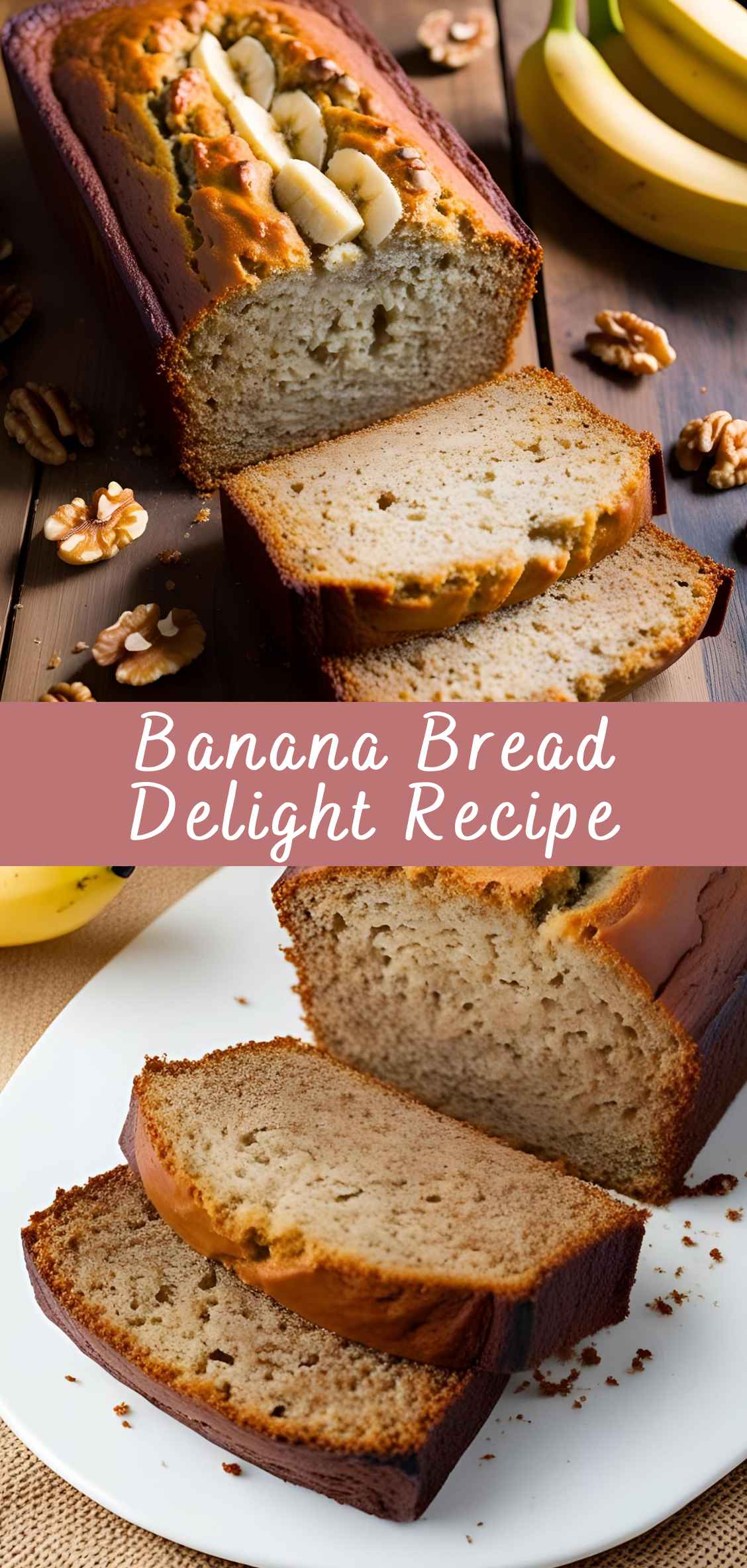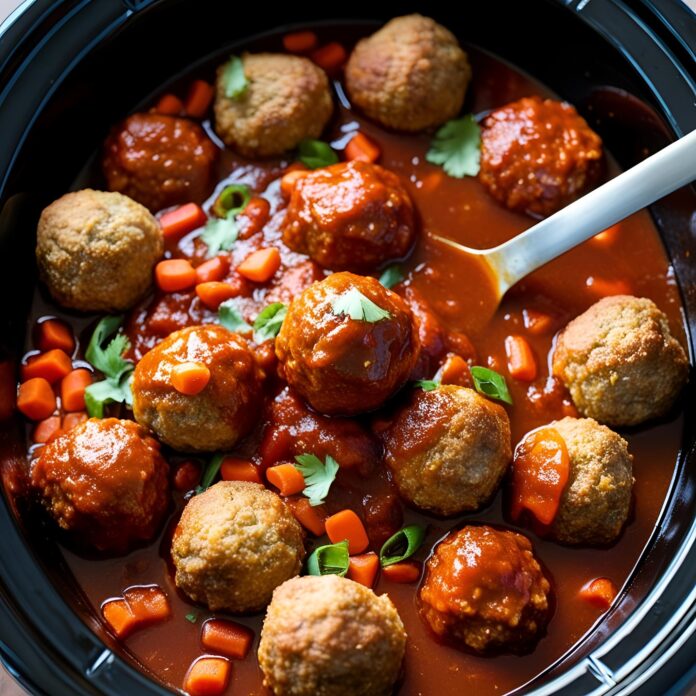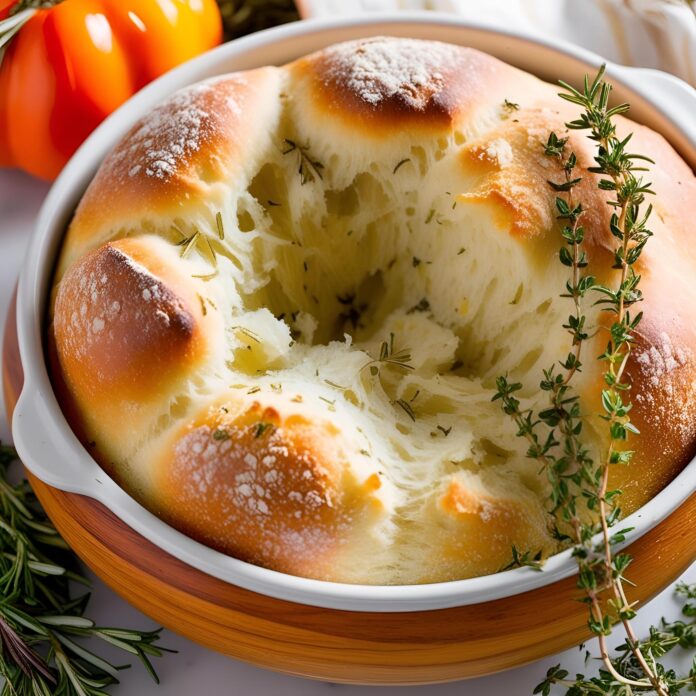Banana Bread Delight Recipe
There’s something undeniably comforting about the scent of banana bread baking in the oven. It’s sweet, warm, and nostalgic—like a hug in loaf form. Banana bread isn’t just a dessert or a breakfast staple. It’s a bridge between generations, cultures, and kitchen experiences. From the overripe bananas on your counter to the moment you slice into a golden loaf, banana bread represents transformation. Something simple becomes something extraordinary.

In every kitchen, from rustic cottages to sleek urban apartments, banana bread has carved out a special place. It’s a go-to recipe for beginners and a canvas for seasoned bakers. Whether you’re baking it to impress guests, use up those soft bananas, or simply treat yourself on a cozy Sunday morning, banana bread offers joy at every step.
In this extensive guide, we’re going to explore banana bread like never before. You’ll learn its fascinating history, understand the science behind that perfect crumb, and master the technique to make your own perfect version—whether you’re a traditionalist or a rule-breaker in the kitchen.
Let’s peel back the layers (pun totally intended) and start this delicious journey together.
History and Origins of Banana Bread
The story of banana bread is one of innovation, necessity, and a little bit of serendipity. While today we might think of it as a cozy classic, banana bread is actually a relatively modern invention—one born out of changing times and evolving kitchen practices.
The Great Depression and Culinary Ingenuity
Banana bread’s popularity soared during the Great Depression in the 1930s. Money was tight, food waste was frowned upon, and home cooks were getting creative with whatever they had. Overripe bananas—once considered trash—suddenly became a treasure. Instead of tossing them, resourceful bakers mashed them up and mixed them into quick breads, creating moist, flavorful loaves with simple ingredients.
These were quick breads, meaning they didn’t require yeast or long rising times. The use of baking soda or baking powder made them accessible and fast—ideal for busy households or inexperienced bakers.
The Rise of Baking Soda and Powder
Another unsung hero in banana bread’s origin story? Chemical leavening. By the 1930s, baking soda and baking powder were becoming kitchen staples. These innovations allowed bakers to produce fluffy, cake-like breads without yeast, paving the way for banana bread to rise—literally and figuratively.
As more households embraced modern appliances like gas ovens and refrigeration, baking became more practical. And with mass marketing, companies like Chiquita began encouraging banana consumption in the U.S., pushing their fruit (and recipes) into the mainstream.
Banana Bread in Cookbooks
The first printed recipes for banana bread started appearing in American cookbooks in the 1930s, with some of the earliest known recipes found in Pillsbury’s and Betty Crocker’s publications. These early versions were often sweeter and denser than today’s lighter interpretations.
By the 1960s and 70s, banana bread became a full-blown household staple. It was the go-to recipe for bake sales, family gatherings, and weekend breakfasts. Home bakers started experimenting—adding walnuts, chocolate chips, spices, and more.
A Global Comfort
Today, banana bread has traveled far beyond its Depression-era roots. Every culture has its take on using bananas in baked goods—from Filipino banana cake to Caribbean banana fritters. But it’s the humble banana bread loaf, often wrapped in parchment or sitting in a grandma’s ceramic dish, that remains iconic.
Step-by-Step Classic Banana Bread Delight Recipe
This is not just a recipe—it’s an experience. Whether you’re a seasoned baker or a first-timer, you’re about to create something beautiful.
Instructions
Step 1: Preheat and Prepare
Preheat your oven to 350°F (175°C).
Grease a 9×5 inch loaf pan with butter or nonstick spray. You can also line it with parchment paper, leaving some overhang for easy lifting.
Pro Tip: If your oven runs hot or you’re using a dark-colored pan, consider reducing the heat to 325°F. Dark pans absorb more heat and can cause over-browning.
Step 2: Mash Those Bananas
In a large mixing bowl, mash the bananas with a fork or potato masher. Leave a few small chunks for added texture, or mash completely smooth for a uniform crumb.
Step 3: Mix the Wet Ingredients
Add the melted butter, sugar, eggs, and vanilla extract to the mashed bananas. Whisk until fully combined. The mixture should be golden and slightly thick, like a smoothie with a purpose.
Why it matters: This ensures even distribution of fat and sugar, which helps your loaf bake evenly and develop flavor.
Step 4: Mix the Dry Ingredients
In a separate bowl, whisk together the flour, baking soda, salt, and cinnamon (if using).
Dry blend tip: Whisking helps prevent lumps and ensures that your leavening agents are spread evenly throughout the flour.
Step 5: Combine Wet and Dry Gently
Add the dry ingredients to the wet ingredients in two parts, using a spatula or wooden spoon to gently fold the mixture. Mix just until no dry flour remains.
Don’t overmix! Overmixing activates the gluten in the flour and can lead to dense, chewy bread. Mix just enough to bring the batter together.
Step 6: Add the Goodies (Optional)
Fold in the nuts, chocolate chips, or any other mix-ins you’re using.
Want a banana-choco swirl? Melt some chocolate chips and gently swirl them through the top layer of the batter before baking.
Step 7: Pour and Smooth
Pour the batter into your prepared loaf pan. Use your spatula to smooth the top.
Optional: Sprinkle a few extra nuts or chips on top for a beautiful finish. You can also slice a banana in half lengthwise and lay it on top for that artisan bakery look.
Step 8: Bake
Bake at 350°F (175°C) for 55 to 65 minutes, depending on your oven and pan.
-
Start checking at 50 minutes.
-
Insert a toothpick into the center: it should come out clean or with a few moist crumbs—no wet batter.
Why banana bread takes time: It’s dense and moist. If it browns too fast, tent it with foil for the final 15 minutes to prevent burning.
Step 9: Cool Down
Let the bread cool in the pan for 10–15 minutes, then use the parchment overhang or a butter knife to loosen the edges and lift it onto a cooling rack. Cool for another 30 minutes before slicing.
⏳ Letting it rest improves texture and flavor. Warm banana bread is heavenly, but cooled banana bread holds together better and slices beautifully.
Serving Suggestions
-
Serve warm with a pat of salted butter or a drizzle of honey.
-
Pair it with a hot coffee, chai latte, or a scoop of vanilla ice cream for dessert.
-
Toast slices and slather with peanut butter, Nutella, or cream cheese for breakfast magic.
Banana Bread Delight Recipe
There’s something undeniably comforting about the scent of banana bread baking in the oven. It’s sweet, warm, and nostalgic—like a hug in loaf form. Banana bread isn’t just a dessert or a breakfast staple. It’s a bridge between generations, cultures, and kitchen experiences. From the overripe bananas on your counter to the moment you slice into a golden loaf, banana bread represents transformation. Something simple becomes something extraordinary.
Ingredients
- 3 ripe bananas, mashed
- 1/3 cup melted butter
- 1/2 cup granulated sugar (adjust to taste)
- 1/4 cup brown sugar (optional for extra depth)
- 1 egg, beaten
- 1 tsp vanilla extract
- 1 tsp baking soda
- Pinch of salt
- 1 1/2 cups all-purpose flour
- Optional add-ins:
- 1/2 cup chopped walnuts or pecans
- 1/2 cup chocolate chips
- 1/2 tsp cinnamon
Instructions
- Preheat oven to 350°F (175°C). Grease a 9x5 inch loaf pan or line with parchment paper.
- Mash the bananas in a large mixing bowl.
- Add melted butter, sugar(s), beaten egg, and vanilla to the mashed bananas. Mix until smooth.
- Sprinkle in baking soda and salt, stir to combine.
- Add flour, mix until just incorporated (do not overmix).
Fold in optional add-ins like nuts or chocolate chips if desired.- Pour batter into prepared loaf pan and smooth the top.
- Bake for 55–60 minutes, or until a toothpick inserted in the center comes out clean.
- Cool in the pan for 10 minutes, then transfer to a wire rack to cool completely.
Notes
- For extra moisture, add 1–2 tablespoons of Greek yogurt or sour cream.
- Overripe bananas (lots of brown spots!) give the best flavor.
- Store tightly wrapped at room temperature for up to 3 days, or refrigerate up to a week.



